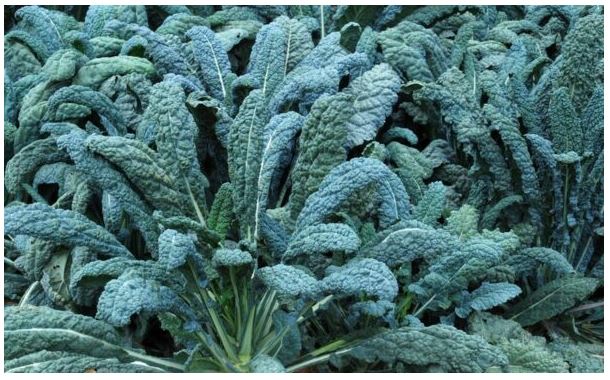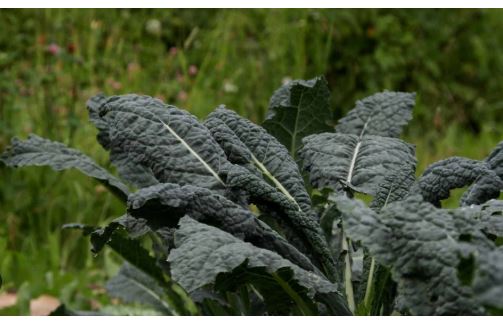
Botanical Classification
Lacinato kale, scientifically classified as Brassica oleracea var. acephala, is a member of the Brassicaceae family, which includes cruciferous vegetables such as cabbage, broccoli, and Brussels sprouts. The acephala variety denotes non-heading brassicas, meaning they form loose, leafy rosettes rather than tight heads.
Lacinato kale is a distinct cultivar within the Brassica oleracea species, known for its unique leaf structure, and shares its genetic lineage with wild cabbage native to the Mediterranean, domesticated for its edible foliage.
Origin and History
Lacinato kale, also known as Tuscan kale, dinosaur kale, or cavolo nero (Italian for “black cabbage”), traces its origins to the Mediterranean, particularly Tuscany, Italy, where it has been cultivated for centuries. Historical records suggest kale-like greens were grown in ancient Greece and Rome, with Lacinato likely emerging as a distinct variety in Italy by the 18th century.
Its name “dinosaur kale” stems from its textured, reptilian-like leaves, a term popularized in modern times. Italian farmers prized it for its hardiness and flavor, incorporating it into regional dishes like ribollita. By the 20th century, Lacinato kale gained global popularity, especially in the U.S., as part of the health food movement, with its cultivation thriving in Ecuador’s fertile highlands alongside other export crops.
Identifying Characteristics

Lacinato kale, also known as Tuscan kale, dinosaur kale, or cavolo nero (“black cabbage” in Italian), originated in the Mediterranean, with strong ties to Tuscany, Italy, where it has been cultivated since at least the 18th century. Kale-like greens were grown in ancient Greece and Rome, and Lacinato likely evolved as a distinct variety in Italy, valued for its hardiness and flavor.
The name “dinosaur kale” reflects its textured, reptilian-like leaves, popularized in the U.S. during the 1990s health food movement. Italian farmers integrated it into regional dishes like ribollita, and its cultivation spread globally, including to the USA, where it thrives in states like California and Oregon, as well as Ecuador’s highlands for export, driven by demand for nutrient-rich greens.
Taste
Lacinato kale has a milder, sweeter flavor compared to other kale varieties, with a subtle earthy bitterness and a nutty undertone. Its texture is tender yet robust, making it less fibrous than curly kale, especially when harvested young. When cooked, it develops a rich, almost meaty flavor, which is why it’s a staple in hearty Italian dishes.
Raw, it offers a delicate crunch and a less intense bite, making it ideal for salads when massaged to soften. The flavor enhances with light frosts, which reduce bitterness, a trait that has made it a favorite for fall and winter harvests.
Seasons/Availability
Lacinato kale is a cool-season crop, thriving in temperatures between 7-24°C (45-75°F), with frost tolerance down to -12°C (10°F). In the USA, it’s planted in early spring (February-March) or late summer (July-August) for harvests in 60-80 days, typically available from late spring (April-May) through early winter (November-December).
It grows well in USDA zones 2-11, with major production in California, Oregon, and New York. Peak flavor occurs in fall after light frosts, and it’s harvested year-round in milder climates like coastal California. Lacinato kale is widely available in U.S. supermarkets, farmers’ markets, and CSA programs, sold fresh, as baby kale, or frozen, with consistent supply due to imports and greenhouse cultivation.
Culinary Uses
Lacinato kale’s versatility makes it a favorite in American and Italian cuisines. Raw, its tender leaves are massaged with oil or citrus for salads, pairing well with nuts, cheeses, or fruits, as seen in trendy U.S. eateries. It’s a popular smoothie ingredient, adding nutrients without overpowering flavors.
In Italian dishes like ribollita or minestrone, it holds up to long cooking, contributing a rich, savory depth. Sautéed with garlic and olive oil or baked into crispy kale chips, it’s a staple side or snack. Young stems are edible, while mature ones can flavor stocks, making it a zero-waste ingredient in U.S. kitchens, from home cooking to farm-to-table restaurants.
Nutritional Value
Lacinato kale is a nutritional powerhouse, low in calories (about 33 per cup raw) and packed with vitamins, minerals, and antioxidants. It’s an excellent source of vitamins K, A, and C, providing over 100% of daily needs per serving, supporting blood clotting, vision, and immune function.
It contains 2-3 grams of fiber per cup, aiding digestion, and is rich in calcium, iron, and magnesium for bone and blood health. Antioxidants like quercetin, kaempferol, and glucosinolates offer anti-inflammatory and potential cancer-preventive benefits. Lacinato kale also provides folate and omega-3 fatty acids, making it a staple for plant-based, health-conscious diets in the USA.
Cultivation of Lacinato kale
- Climate and Season: Lacinato kale grows best in cool weather, with optimal temperatures between 7-24°C (45-75°F), and tolerates frosts down to -12°C (10°F). In the USA, plant in early spring (February-March) or late summer (July-August) for spring and fall harvests. It thrives in USDA zones 2-11, with year-round cultivation in mild regions like coastal California and peak fall harvests in colder states like Vermont.
- Site Selection: Choose a site with full sun (6-8 hours daily) to promote robust leaf growth, though partial shade is tolerated in warmer states like Florida or Texas to delay bolting. Ensure good air circulation to reduce fungal disease risk, especially in humid areas like the Southeast.
- Soil Requirements: Prefers fertile, well-drained, loamy soil with a pH of 6.0-7.5. Enrich with organic matter like compost or aged manure. In regions with heavy clay (e.g., Midwest) or sandy soils (e.g., Southeast), amend with compost to improve drainage and fertility, supporting tender leaf production.
- Soil Preparation: Loosen soil to 12 inches deep, mixing in 2-3 inches of compost or organic matter. Remove rocks and debris to facilitate root development. Conduct a soil test via local extension services (e.g., USDA’s NRCS) to confirm pH and nutrient levels, adjusting with lime or sulfur as needed for optimal growth.
- Planting: Sow seeds ¼-½ inch deep, spacing 12-18 inches apart in rows 18-24 inches apart to accommodate its 18-24 inch height. Transplant seedlings started indoors 6-8 weeks earlier for faster harvests, common in shorter-season areas like the Northeast. In warmer regions like California, direct sowing works well.
- Watering: Maintain consistent soil moisture, providing 1-1.5 inches of water weekly, adjusting for rainfall. Use drip irrigation, common in arid states like Arizona, to keep leaves dry and reduce disease risk. Mulch to retain moisture, especially in hot, dry regions like the Southwest.
- Fertilization: Apply a balanced fertilizer (e.g., 10-10-10) at planting, followed by a nitrogen-rich fertilizer (e.g., fish emulsion) every 4-6 weeks to encourage leafy growth. Avoid over-fertilizing, which can attract pests in humid areas like the Gulf Coast and affect flavor quality.
- Mulching: Add a 2-3 inch layer of organic mulch, such as straw, wood chips, or shredded leaves, to conserve moisture, suppress weeds, and keep roots cool. This is critical in regions with temperature swings, like the Midwest, or hot summers, like the Southeast, to stabilize soil conditions.
- Pest Management: Monitor for pests like aphids, cabbage worms, and flea beetles, prevalent in U.S. kale crops. Use floating row covers in organic farms (e.g., Oregon), neem oil, or introduce beneficial insects like ladybugs, popular in California. Hand-pick caterpillars for small gardens, effective nationwide.
- Disease Control: Prevent fungal diseases like powdery mildew and black rot, common in humid regions like the Southeast, by ensuring air circulation and avoiding overhead watering. Rotate crops every 2-3 years, standard in intensive farming states like California, to reduce soil-borne pathogens.
- Harvesting: Harvest outer leaves when 8-10 inches long, about 60-80 days after planting, cutting close to the stem to encourage regrowth. Start in late spring (April-May) or fall (September-November), with sweeter leaves post-frost in colder states like Minnesota. Regular harvesting extends yield through the season.
- Succession Planting: Sow seeds every 2-3 weeks in spring or fall for a continuous supply, a common practice in mild climates like California’s Central Valley. In shorter-season regions like Wisconsin, focus on spring and late summer plantings to maximize harvests before hard freezes.
- Storage and Preservation: Store fresh Lacinato kale at 0-4°C (32-40°F) in a perforated plastic bag in the refrigerator for up to 2-3 weeks, standard for U.S. households. For long-term storage, blanch leaves for 2-3 minutes, cool in ice water, dry thoroughly, and freeze to preserve nutrients, a popular method for winter use. Wash and dry before storing to maintain freshness.